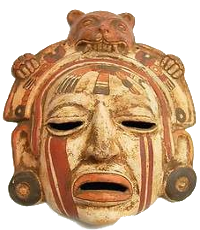Books from ancient Mexico
A codex, in the context of the history of the Americas, refers to a book put together before or right at the time of the European conquest. Both Mayas and Aztecs had a tradition of making such books. They describe their customs and rituals, the history of the respective empire, but also the encounter between them and the Europeans. Today there are at least 500 codices in existence in libraries around the world. They are our best source of information about life in pre-Columbian Mexico.
The most important example is the Dresden Codex, a work consisting of 78 pages, dating from the thirteenth- or the fourteenth-century CE. It was lost for many years but eventually rediscovered in a library in Germany, hence its name. The Dresden Codex was of great importance for scholars trying to decipher the Maya script.[Read more: “Cracking the Maya code“] It contains astronomical information as well as the schedules for rituals such as the celebration of the Maya new year. The book suffered serious water damage during the allied bombings during the Second World War.
The Florentine Codex is the most important Aztec codex. It was compiled by a Spanish priest, Bernardino de Sahagún, with the help of his native students. The work has 2,400 pages and more than 2,000 images, organized into twelve books. It describes the culture of the Aztecs, their cosmology and rituals, but also social and economic conditions and the history of the Aztec people. Sahagún’s aim was to facilitate the conversion of the Aztecs to Christianity. We need information about the Aztecs, he argued, just as a doctor needs information about the illnesses of patients in order to cure them. The Florentine Codex was written in Nahuatl, the language of the Aztecs, but has been translated into Spanish and English. It is today available online.
The Incas did not compile similar books, but an important primary source for their society and culture is the work of Inca Garcilaso de la Vega, 1539-1616 CE. He was the son of a Spanish conquistador and an Inca noblewoman. His account was written when Garcilaso de la Vega had retired to Spain, but it provides a history of the Incas from a native point of view.
External links:
- Dresden Codex, high-resolution pdf
- FAMSI, “The Ancient Maya Codices”
- Frances Berdan & Patricia Rieff Anawalt, The Essential Codex Mendoza
- Handbook of Middle American Indians
- Internet Archive, Works by Garcilaso de la Vega
- Karl Young, “The last pages of Codex Boturini”
- Maya Codex – The Quetzalcoatl Message
- The Precolumbian Portfolio, “The Grolier Codex”
- Thomas J. Tobin, “The Construction of the Codex In Classic- and Postclassic-Period Maya Civilization”
- World Digital Library, Florentine Codex


